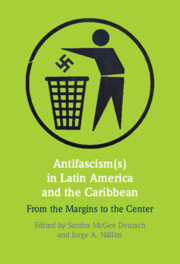Refine search
Actions for selected content:
614 results
Indigenous archaeology in Latin America. Towards an engaged, activist and intercultural archaeology
-
- Journal:
- Archaeological Dialogues , First View
- Published online by Cambridge University Press:
- 26 September 2025, pp. 1-19
-
- Article
-
- You have access
- Open access
- HTML
- Export citation
8 - Plurinational Juristocracy and Rights from Below at Bolivia’s Gas Frontier
-
-
- Book:
- Reckoning with Law in Excess
- Published online:
- 09 September 2025
- Print publication:
- 25 September 2025, pp 186-211
-
- Chapter
-
- You have access
- Open access
- HTML
- Export citation
Between equality and stagnation: a comparative evaluation of paid parental leave policies in Latin America
-
- Journal:
- International Journal of Law in Context , First View
- Published online by Cambridge University Press:
- 22 September 2025, pp. 1-20
-
- Article
-
- You have access
- Open access
- HTML
- Export citation
Wage inequality in manufacturing and the unskilled in Latin America: a dataset 1920–2011
-
- Journal:
- Revista de Historia Economica - Journal of Iberian and Latin American Economic History , First View
- Published online by Cambridge University Press:
- 17 September 2025, pp. 1-17
-
- Article
- Export citation
Argentina’s creditworthiness achievements and problems, 1955–1962: the role of institutions, policymakers, and external agents
-
- Journal:
- Revista de Historia Economica - Journal of Iberian and Latin American Economic History , First View
- Published online by Cambridge University Press:
- 12 September 2025, pp. 1-21
-
- Article
- Export citation
Mental healthcare needs and opportunities in Guatemala
- Part of
-
- Journal:
- BJPsych International , FirstView
- Published online by Cambridge University Press:
- 08 September 2025, pp. 1-3
-
- Article
-
- You have access
- Open access
- HTML
- Export citation
Misinformation Among Migrants: Evidence from Mexico and Colombia
-
- Journal:
- Journal of Experimental Political Science , First View
- Published online by Cambridge University Press:
- 01 September 2025, pp. 1-12
-
- Article
-
- You have access
- Open access
- HTML
- Export citation
1 - Punishment Is Part of Tort Law
- from Part I - The Place of Punishment in Torts
-
- Book:
- Torts and Retribution
- Published online:
- 09 August 2025
- Print publication:
- 28 August 2025, pp 21-49
-
- Chapter
- Export citation
Introduction
-
- Book:
- The Birth of Democracy in South America
- Published online:
- 04 June 2025
- Print publication:
- 07 August 2025, pp 1-16
-
- Chapter
-
- You have access
- Open access
- HTML
- Export citation
2 - Elections and Democracy in South America before 1930
-
- Book:
- The Birth of Democracy in South America
- Published online:
- 04 June 2025
- Print publication:
- 07 August 2025, pp 48-73
-
- Chapter
-
- You have access
- Open access
- HTML
- Export citation
4 - The Origins of Strong Parties in South America
-
- Book:
- The Birth of Democracy in South America
- Published online:
- 04 June 2025
- Print publication:
- 07 August 2025, pp 98-122
-
- Chapter
-
- You have access
- Open access
- HTML
- Export citation
1 - Armies, Parties, and the Birth of Democracy
-
- Book:
- The Birth of Democracy in South America
- Published online:
- 04 June 2025
- Print publication:
- 07 August 2025, pp 17-47
-
- Chapter
-
- You have access
- Open access
- HTML
- Export citation
Introduction
-
-
- Book:
- Antifascism(s) in Latin America and the Caribbean
- Published online:
- 21 July 2025
- Print publication:
- 07 August 2025, pp 1-22
-
- Chapter
- Export citation
3 - Military Professionalization and the Decline of Revolts in South America
-
- Book:
- The Birth of Democracy in South America
- Published online:
- 04 June 2025
- Print publication:
- 07 August 2025, pp 74-97
-
- Chapter
-
- You have access
- Open access
- HTML
- Export citation
Conclusion
-
- Book:
- The Birth of Democracy in South America
- Published online:
- 04 June 2025
- Print publication:
- 07 August 2025, pp 302-316
-
- Chapter
-
- You have access
- Open access
- HTML
- Export citation
1 - Political Legitimacy as an Intellectual Journey
- from Part I - Setting the Stage
-
- Book:
- The Law and Politics of International Legitimacy
- Published online:
- 14 July 2025
- Print publication:
- 24 July 2025, pp 11-23
-
- Chapter
- Export citation

Antifascism(s) in Latin America and the Caribbean
- From the Margins to the Center
-
- Published online:
- 21 July 2025
- Print publication:
- 07 August 2025
Zoonotic parasitic diseases in South America: why early-career researchers matter
-
- Journal:
- Parasitology , First View
- Published online by Cambridge University Press:
- 14 July 2025, pp. 1-6
-
- Article
-
- You have access
- Open access
- HTML
- Export citation
Navigating the future: horizon scanning and early dialogue in health technology assessment in Latin America
- Part of
-
- Journal:
- International Journal of Technology Assessment in Health Care / Volume 41 / Issue 1 / 2025
- Published online by Cambridge University Press:
- 10 July 2025, e42
-
- Article
-
- You have access
- Open access
- HTML
- Export citation
3 - Reducing Inequality in Consumer Transactions
-
-
- Book:
- Legal Heterodoxy in the Global South
- Published online:
- 19 June 2025
- Print publication:
- 03 July 2025, pp 77-111
-
- Chapter
-
- You have access
- Open access
- HTML
- Export citation
